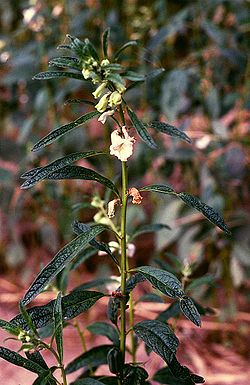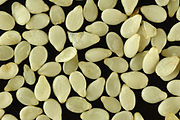
Sesame
Background Information
This selection is made for schools by a children's charity read more. Sponsor a child to make a real difference.
| Sesame | |
|---|---|
 |
|
| Sesame plants | |
| Scientific classification | |
| Kingdom: | Plantae |
| Division: | Magnoliophyta |
| Class: | Magnoliopsida |
| Order: | Lamiales |
| Family: | Pedaliaceae |
| Genus: | Sesamum |
| Species: | S. indicum |
| Binomial name | |
| Sesamum indicum L. |
|
Sesame (Sesamum indicum) is a flowering plant in the genus Sesamum. The precise natural origin of the species is unknown, although numerous wild relatives occur in Africa and a smaller number in India. It is widely naturalized in tropical regions around the world and is cultivated for its edible seeds.
It is an annual plant growing to 50 to 100 cm (2-3 feet) tall, with opposite leaves 4 to 14 cm (5.5 in) long with an entire margin; they are broad lanceolate, to 5 cm (2 in) broad, at the base of the plant, narrowing to just 1 cm (half an inch) broad on the flowering stem. The flowers are white to purple, tubular, 3 to 5 cm (1 to 2 in) long, with a four-lobed mouth.
Origins
Despite the fact that the majority of the wild species of the genus Sesamum are native to sub-saharan Africa, Zohary and Hopf argue that sesame was first domesticated in India. They cite morphological and cytogenetic affinities between domesticated sesame and the south Indian native S. mulayanum Nair., as well as archeological evidence that it was cultivated at Harappa in the Indus Valley between 2250 and 1750 BC, and a more recent find of charred sesame seeds in Miri Qalat and Shahi Tump in the Makran region of Pakistan. They regard the identification of sesame seeds in the finds from the tomb of Tutankhamen from ancient Egypt "might be true, but are in need of further verification."
Etymology
The word sesame is from Latin sesamum, borrowed from Greek sēsámon "seed or fruit of the sesame plant", borrowed from Semitic (cf. Aramaic shūmshĕmā, Arabic simsim), from Late Babylonian *shawash-shammu, itself from Assyrian shamash-shammū, from shaman shammī "plant oil".
In India, where sesame has been cultivated since the Harappan period, there are two independent names for it: Sanskrit tila [तिल] (Hindi/Urdu til [तिल, تل]) is the source of all names in North India - ex. Gujrati and Bengali it is til ( তিল). In contrast, most of the Dravidian languages in South India feature an independent name for sesame exemplified by Tamil, Malayalam and Kannada ellu [எள்ளு, എള്ള്, ಎಳ್ಳು] and Telugu "Nuvvulu"(నువ్వులు).
From all the 3 roots above, words with the generalized meaning “oil; liquid fat” are derived, e.g., Sanskrit taila [तैल]. Similar semantic shifts from the name of an oil crop to a general word “fat, oil” are also known for other languages, e.g., “olive” has given rise to English “oil”.
In some languages of the Middle East, sesame is named differently and evolved from Middle Persian kunjid. This has been imported into a few western languages - ex. Russian kunzhut [кунжут], Estonian kunžuut and Yiddish kunzhut [קונזשוט].
Portuguese (Brazil only) gergelim and Spanish ajonjolí (sesame seeds) and Hindi gingli [गिंगली] derive from an Arabic noun jaljala [جلجلة] “sound, echo”, referring to the rattling sound of ripe seeds within the capsule.
In southern US and the Caribbean, where the sesame seed was introduced by Slaves imported from Africa, it is also known by an African name, benne.
Mythological background
According to Assyrian legend, when the gods met to create the world, they drank wine made from sesame seeds. In early Hindu legends, tales are told in which sesame seeds represent a symbol of immortality. " Open sesame," the famous phrase from the Arabian Nights, reflects the distinguishing feature of the sesame seed pod, which bursts open when it reaches maturity..
It is also used in Urdu literature as proverbs "til dharnay ki jagah na hona"; meaning by, a place so crowded that there is no room for a single seed of sesame and "in tilon mein teil nahee" (ان تلوں میں تیل نہیں); referred for a person who is very mean, meaning by there is no oil left in this sesame.
In recent times the seeds have become an ingredient in wiccan practices. Cunningham's Encyclopedia of Wicca in the Kitchen suggests their use to aid conception, to draw money, or for protection.
Uses in food and cuisines
Sesame is grown primarily for its oil-rich seeds, which come in a variety of colors, from cream-white to charcoal-black. In general, the paler varieties of sesame seem to be more valued in the West and Middle East, while the black varieties are prized in the Far East. The small sesame seed is used whole in cooking for its rich nutty flavour (although such heating damages their healthful poly-unsaturated fats), and also yields sesame oil.
Sesame seeds are sometimes added to breads, including bagels and the tops of hamburger buns. Sesame seeds may be baked into crackers, often in the form of sticks. Sesame seeds are also sprinkled onto some sushi style foods. Whole seeds are found in many salads and baked snacks as well in Japan. Tan and black sesame seed varieties are roasted and used for making the flavoring gomashio. In Greece seeds are used in cakes, while in Togo, seeds are a main soup ingredient. The seeds are also eaten on bread in Sicily and France (called "ficelle sésame", sesame thread). About one-third of the sesame crop imported by the United States from Mexico is purchased by McDonald's for their sesame seed buns (The Nut Factory 1999). In Punjab province of Pakistan and Tamil Nadu state of India, a sweet ball called "Pinni" (پنی) in Urdu and 'Ell urundai' in Tamil, is made of its seeds mixed with sugar. Also in Tamil Nadu, 'Milakai Podi', a ground powder made of sesame and dry chili is used to enhance flavor and consumed along with other traditional foods such as idli. Sesame (benne) seed cookies and wafers, both sweet and savory, are still consumed today in places like Charleston, South Carolina - and the seeds are believed to have been brought into 17th century colonial America by West African slaves.
Ground and processed, the seeds can also be used in sweet confections. Sesame seeds can be made into a paste called tahini (used in various ways, including in hummus) and a Middle Eastern confection called halvah. In India, sections of the Middle East, and East Asia, popular treats are made from sesame mixed with honey or syrup and roasted (called pasteli in Greece). In Japanese cuisine goma-dofu (胡麻豆腐) is made from sesame paste and starch.
East Asian cuisines, like Chinese cuisine use sesame seeds and oil in some dishes, such as dim sum, sesame seed balls ( Chinese: 麻 糰; pinyin: mátuǎn or 煎堆; Cantonese: jin deui), and the Vietnamese bánh rán. Sesame flavour (through oil and roasted or raw seeds) is also very popular in Korean cuisine, used to marinate meat and vegetables. Chefs in tempura restaurants blend sesame and cottonseed oil for deep-frying. Sesame oil was the preferred cooking oil in India until the advent of groundnut (peanut) oil.
Although sesame leaves are edible as a potherb , recipes for Korean cuisine calling for "sesame leaves" are often a mistranslation, and really mean perilla .
-
Sesame.jpg
Thai workers harvesting sesame
Nutrition and health treatments
The seeds are rich in manganese, copper, and calcium (90 mg per tablespoon for unhulled seeds, 10 mg for hulled), and contain vitamin B1 (thiamine) and vitamin E (tocopherol). They contain lignans, including unique content of sesamin, which are phytoestrogens with antioxidant and anti-cancer properties. Among edible oils from six plants, sesame oil had the highest antioxidant content. Sesame seeds also contain phytosterols associated with reduced levels of blood cholesterol, but do not contain caffeine. The nutrients of sesame seeds are better absorbed if they are ground or pulverized before consumption.
Women of ancient Babylon would eat halva, a mixture of honey and sesame seeds to prolong youth and beauty, while Roman soldiers ate the mixture for strength and energy .
While sesame seeds are generally considered nutritious, they produce one of the uncommon food allergies, 5-13 per 100,000 .
There have been erroneous claims that sesame seeds also contain THC which may be detectable on random screening. This error stems from a misunderstanding of the commercial drug Dronabinol, a synthetic form of THC. The normal delivery mechanism for synthetic Dronabinol is via infusion into sesame oil and encapsulation into soft gelatin capsules. As a result some people are under the mistaken assumption that sesame oil naturally contains THC. In fact, THC, CBD, CBN and the other cannibinoids are unique to the Cannabis genus.
Sesame oil is used for massage and health treatments of the body in the ancient Indian ayurvedic system with the types of massage called abhyanga and shirodhara. Ayurveda views sesame oil as the most viscous of the plant oils and believes it may pacify the health problems associated with Vata aggravation.
Cultivation
Sesame is grown in many parts of the world on over 5 million acres (20,000 km²). The largest producer of the crop in 2007 was India, followed by China, Myanmar, Sudan, Ethiopia, Uganda and Nigeria. Seventy percent of the world's sesame crop is grown in Asia, with Africa growing 26%.
Beginning in the 1950s, U.S. production of the crop has been largely centered in Texas, with acerage fluctuating between 10,000 to 20,000 acres (40 to 80 km²) in recent years. The country's crop does not make up a significant global source; indeed imports have now outstripped domestic production.
Pests
Sesame is used as a food plant by the larvae of some Lepidoptera species, including the Turnip Moth.





